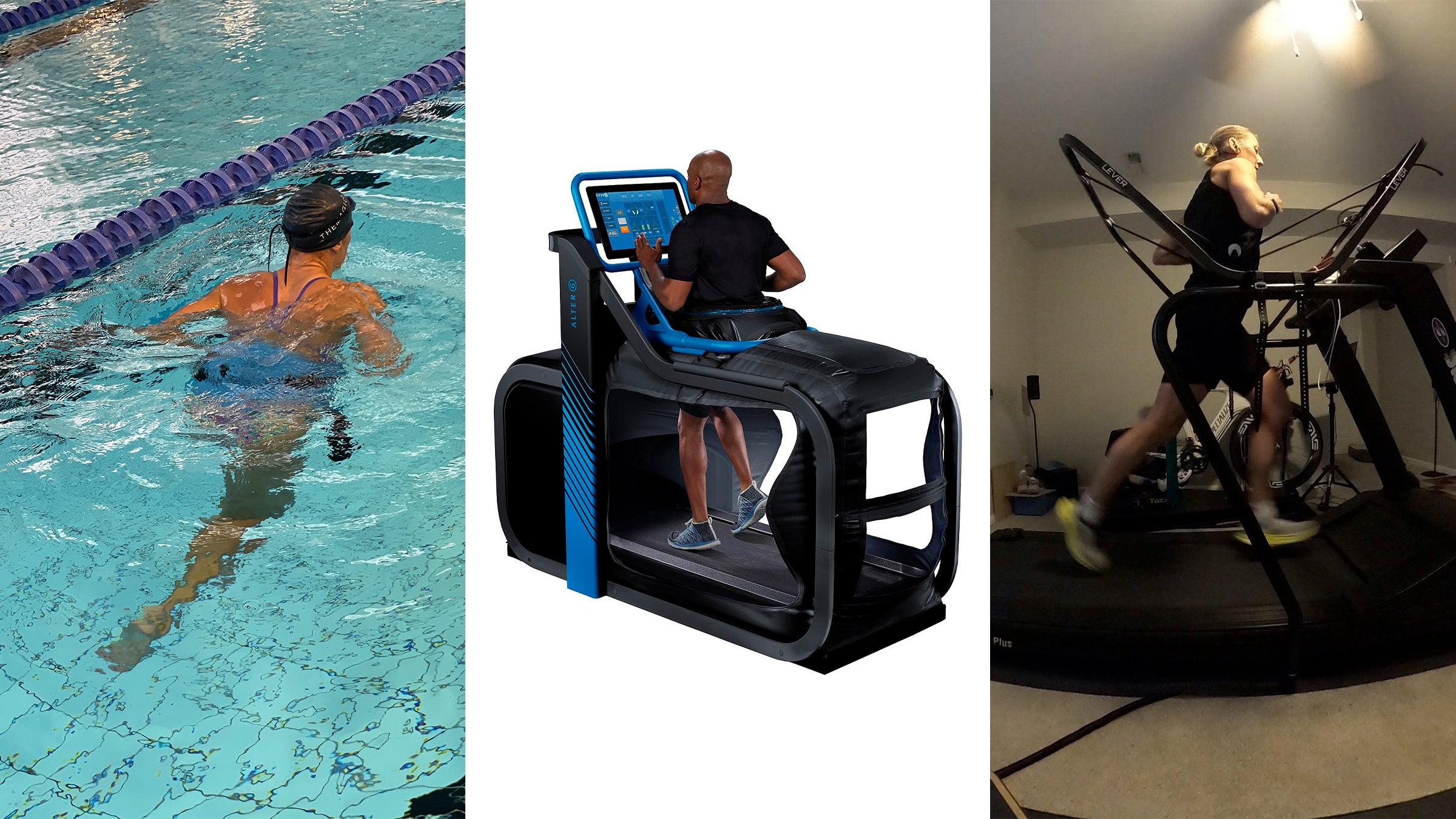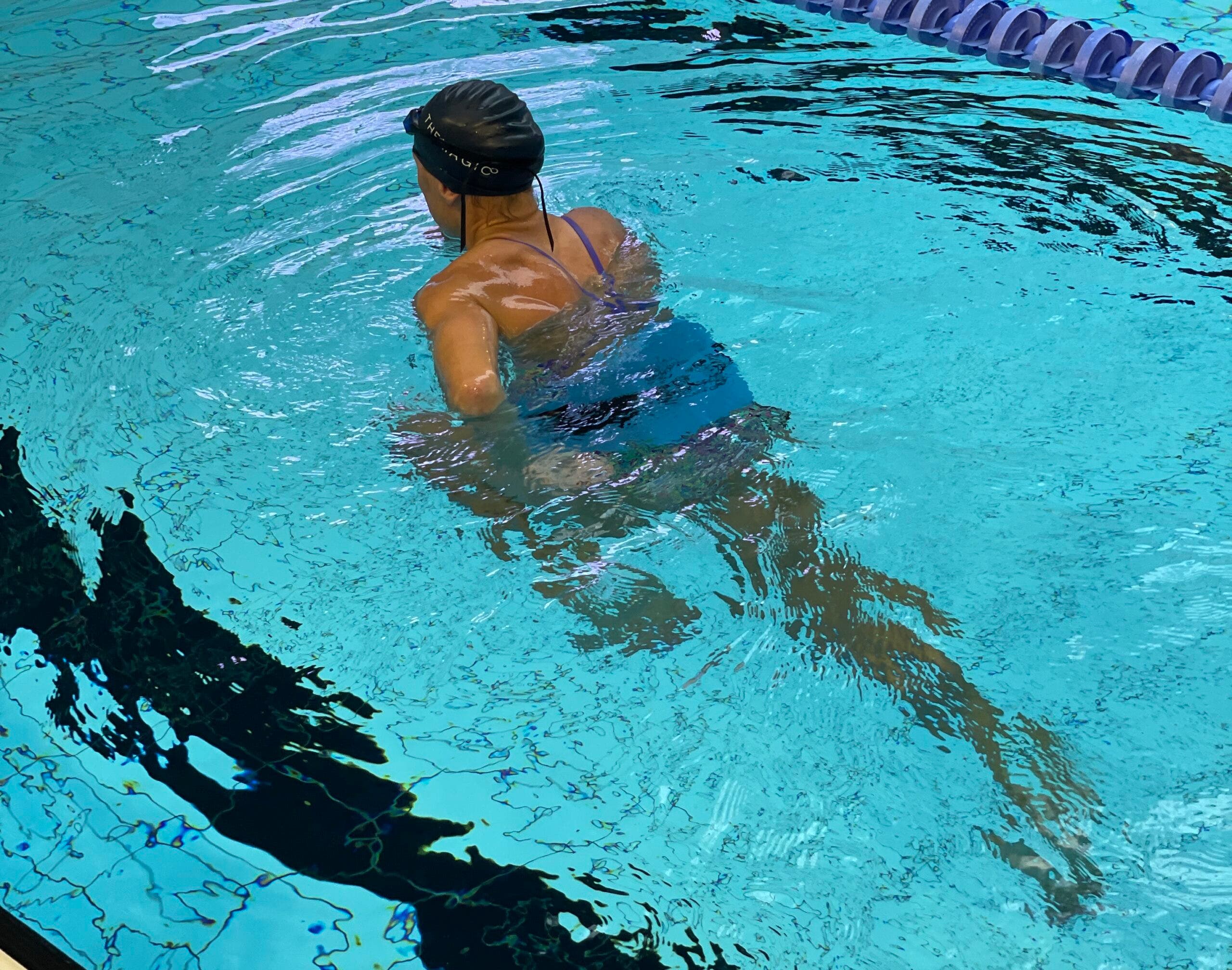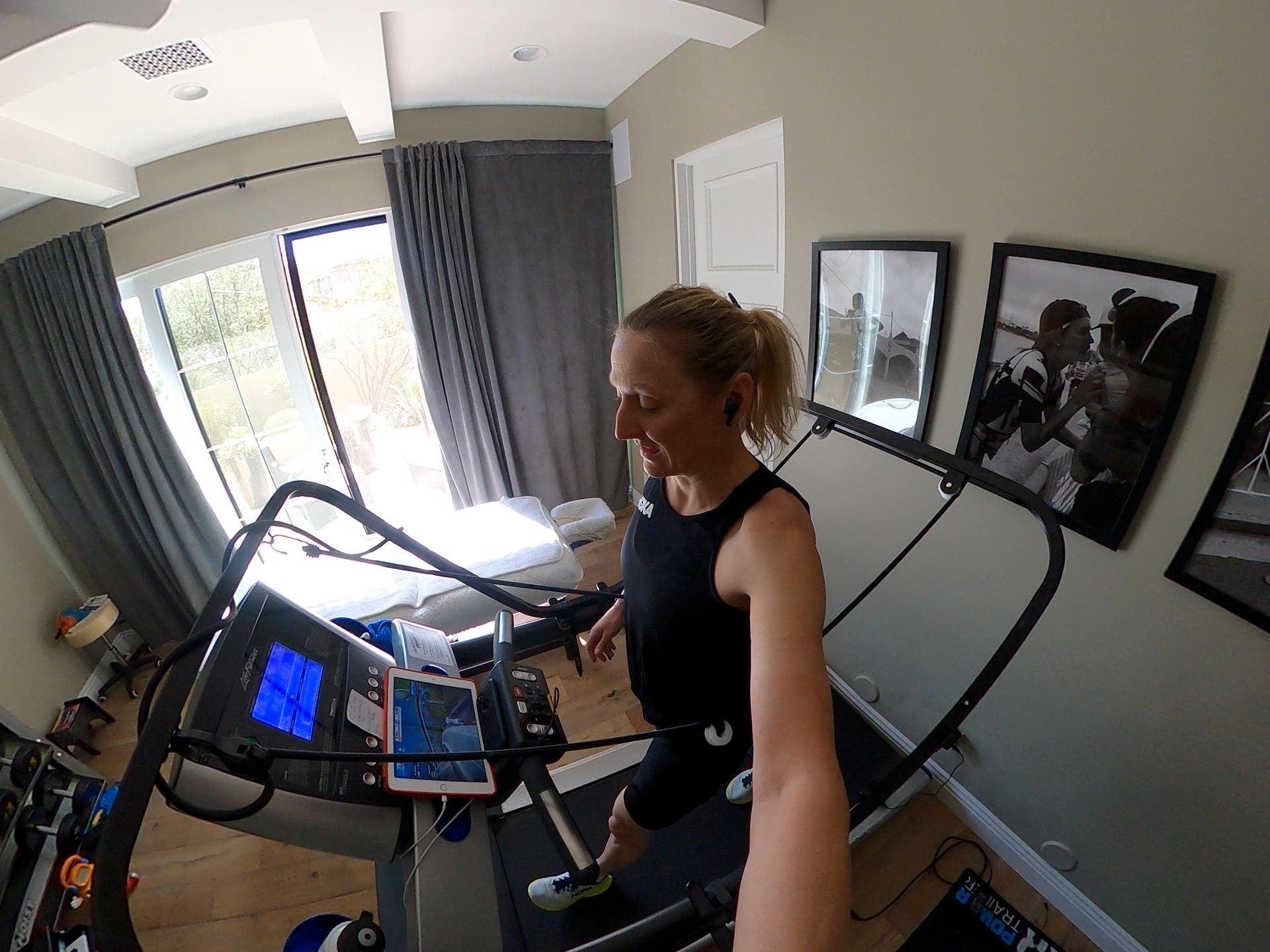Injured? What's the Best Running Alternative: Alter G, Water Running, or Lever

At some point, you will likely find yourself having to deal with or manage an injury, which can put a damper on your running (in more ways than one). This for me was December 2019, when I tore the fascia in my calf—resulting in a 12- to 16-week rehab process. Along with following a rehab, strength, and nutrition program, my coach and I also looked at what I could do for training. As you probably have heard many people say: focus on what you can do, in order to help recovery in the best possible way.
Related: A Pro Look at the Lever Running Treadmill Device
In general, the run-like alternative options for injured athletes are: pool or water running, running on an Alter G, or the new Lever running system that attaches to a treadmill. All three are valuable and could, in fact, all be used to complement each other. But what are the benefits of each? Is one better than the other? Don’t panic just because you’re injured; we’ve broken it down for you.

Running Injury Alternative #1: AlterG
What is it?
AlterG stands for Anti-Gravity Treadmill. It was originally developed for NASA, to help astronauts maintain their strength and bone density while in space, since spending increasing periods of time in zero-gravity environments was resulting in a loss of weight and bone density for the astronauts. The solution? A pressurized air chamber to simulate some gravitational load. It was subsequently recognized, that the converse, reduction of gravity’s effect could have significant benefits for people back on earth—namely those who don’t want to put a full load on their legs or feet, like injured athletes. The NASA solution was reverse engineered to create the differential air pressure system used now in the AlterG treadmill.
How Does it Work?
The AlterG comes with a pair of shorts you wear and what looks a bit like a kayaking spray skirt around the top. Walking on to the AlterG treadmill from the back, you pull up a huge chamber that encompasses your lower body and zips onto the skirt attached to the shorts, creating a seal. The amount of “gravity” (ie. pressure) can then be reduced, so you can go from 100% bodyweight down to 20%, in 1% increments. Some of the machines have sensors and cameras to give you gait analysis, stride length, cadence, balance, and more metrics. In theory, this could help you (or your therapists and coaches) control and manage your rehab and training.
AlterG Pros
- It can allow you start running again sooner, while still protecting you from impact and load.
- Even if you’re just dealing with niggles or pre-emptively trying to mitigate high mileage load, it can let you increase running volume while minimizing stress-related injuries.
- The ability to reduce bodyweight from full weight down to 20% in 1% increments.
- The video footage and run gait analysis on some of the high-end models can be very helpful.
AlterG Cons
- The cost of an AlterG can set you back anything from $35,000-75,000. So you’re probably not buying one yourself, but using one in a sports performance center or rehab facility.
- That can make it challenging to locate an AlterG for use; and once you find one it’ll probably set you back about $35-50 per 30- or 60-minute session.
- It can get very very sweaty in those neoprene shorts, and you may find yourself running with an odd arm carriage in order to avoid hitting your arms on the bubble.
More Information: www.alterg.com

Running Injury Alternative #2: Aqua Jogging
What is it?
Known as water running, pool running, or aqua jogging, this is not water aerobics, but is an actual replacement for running with low impact—since in this case the water (as opposed to a pressurized chamber) removes the full effect of gravity. Again, water running is not just for running rehab, but can be used in a normal routine to allow the body to recover from the impact of training while still working on technique and fitness. The water also adds a resistance but again without the impact.
How Does it Work?
Contrary to what it may sound like, typically you don’t actually run across the bottom of the pool (though you can, as an option, but it’s not generally how one starts out). Water running is typically done in deep water, using a running motion to stay afloat. Because of the challenges involved with staying afloat in water, it’s often best to use a flotation belt in order to give yourself a bit of help with buoyancy and allow you to focus on your form and technique, as well as get the heart rate up to have a cardiovascular workout as well. The focus should be on maintaining good form that you can then translate to out of the water when back running fully. It can be tempting to tread water more than “run” and sneak in little tricks that move you forward in the water, but don’t. (eg. Be careful not to scull with your hands in the water, by cupping them.) This is where a flotation belt can help.
RELATED: Aqua Jogging for Injured Runners
Aqua Jogging Pros:
- Lower cost, since you probably have access to a pool already.
- Limited equipment, with just a flotation belt necessary.
- Gives you the ability to work on technique, and keep the neuromuscular memory.
- Fun fact: Tim O’Donnell came second in Kona 2019, just weeks after a foot injury, by using water running to maintain form and fitness.
Aqua Jogging Cons:
- It can be very (very) mind-numbing and boring. Would recommend using headphones.
- Finding a pool deep enough can sometimes be tricky or one that will let you water run back and forth in the deep end.
- Some find it hard to see the connection between aqua jogging and translating it to real running outside. This can often be if you’re not getting the form right.
- Can be easy to accidentally end up treading water, or make small changes to your “run” technique to propel you forward in the water but aren’t helpful for translating to running.

Running Injury Alternative #3: Lever Runner
What is it?
The Lever Runner, similar to the AlterG, suspends part of your body weight. Lever use a skeleton frame and elastic cord to hold the runner slightly above the treadmill, allowing them to move under partial body weight support. You can take up to about 45 pounds off your bodyweight. This means that you can run (or walk) on the treadmill, but with less impact on muscles and joints, which can be helpful in returning from injury or maintaining high-volume training while reducing the likelihood of injury.
How Does it Work?
With the Lever Runner, you also wear a pair of neoprene shorts and on the side of the shorts are two nylon pulleys. The frame is fairly simple to put together and attaches to the arms of the treadmill with straps. A bungee cord then connects from the front of the frame, through the pulley on the sides of the shorts, and feeds through two more pulleys connected to the back of the frame. The more you pull the bungee cord before securing it the more weight you take off. And just like that you’re basically a baby in a baby swing, running along the treadmill.
Lever Runner Pros:
- It’s more affordable than an AlterG, at around $1,000 plus $99 for the shorts.
- Very easy to build yourself and fit onto most treadmills.
- It also packs up easily, so you can take it with you to a gym or as you travel. (That means you don’t have to also buy a treadmill.)
- Allows you to start running again, sooner, while still being protected from impact and loading. Similarly to the AlterG, you can also increase running volume while minimizing stress-related potential injuries.
Lever Runner Cons:
- Compared to the AlterG, the Lever can only reduce your bodyweight up to 45lbs.
- The current system for figuring out how much weight you’ve removed is just painted markers on the bungee cord that do wear off with time. A better and more accurate system is being developed.
- Only fits to treadmills with arms. Adaptors are available for the Woodway.
- Initially there can also be some static build-up with the bungee cord and nylon pulleys, giving the athlete a little shock each time they touch the treadmill. This goes after a few sessions.
- Some runners may need to change their arm carriage, depending on height.
- It’s still not super cheap.
More information: www.leverrunning.com
Verdict: What’s the best running injury alternative?
All three systems are incredible valuable for athletes (or in fact anyone) wanting to keep moving, but still reduce the impact and load on muscles and bones. For athletes, all three are powerful tools to return from injury, or prevent overuse injuries.
Aqua jogging should probably be your first port of call, regardless, since it’s easy to work on maintaining fitness and technique. However, if you’re then trying to expand your options or have a long rehab in front of you, you’ll likely find the other two more robust as options. While AlterG has a greater range and analysis functionality, it’s very expensive and not readily available for everyone. The Lever Runner, while it perhaps doesn’t have the level of accuracy and detail as the AlterG, is a fraction of the price, making it a much more affordable and worthwhile investment—especially if you’re the kind of athlete consistently prone to overuse injuries. Being so lightweight and easy to assemble and travel with, it means you’re guaranteed to have access to the system wherever you are. This is particularly helpful for the world-traveling high-intensity elite athlete, which is probably why you’re seeing more and more pros turning to the Lever to help with rehab and injury prevention.